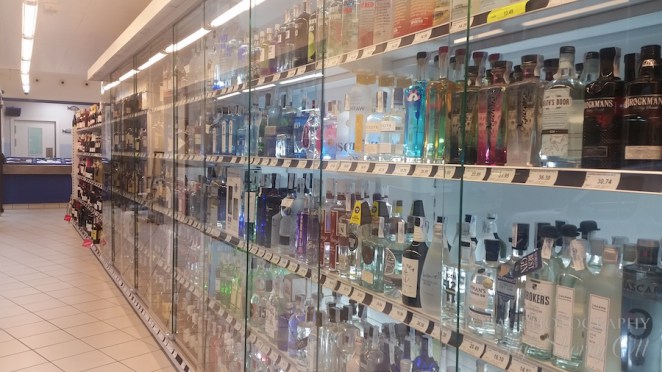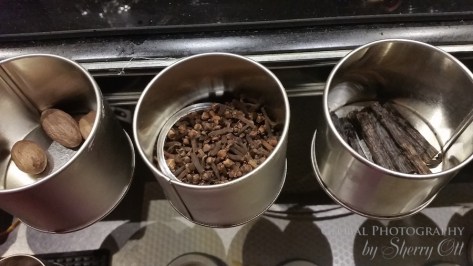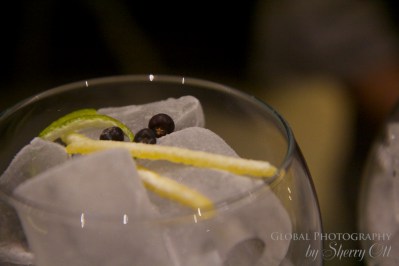
So that’s what the swizzle spoon is used for!!
There I stood dumbfounded, my mind was racing; how could have I got this all wrong my whole life? I’m in denial as I listen to bar owner and Chef, Ramona Pau, walk us through the steps of making a gin and tonic. It was sort of like when I learned that kissing a boy didn’t make you pregnant, and learned what sex was for the first time; how it worked, what parts went where, and the end result. One of those moments where you know at that point you’ll never be the same, and you’ll never look at boys the same way. Similarly, after this evening with Ramona Pau, I’ll never be able to look at gin and tonics again in the same way.
One of the things I do well is drink, and gin is one of my favorite liquors. I’ve made and enjoyed gin and tonics my whole adult life. I thought I knew gin and tonics, but I was now humbled as I watched and listed to Ramona walk us through the correct gin and tonic process at his gin and tonic bar in Ribes de Freser Spain. The Lobby Bar, part of the Hotel els Caçadors, specializes in serving gin. You might think this is limiting, however when you have over 100 bottles of different gin and 45 different tonics on the shelves, you’ve got infinite choices! And if I were better at math and didn’t drink so much gin, I could probably tell you exactly how many combination choices you’d have.
You might think this type of bar is unique, however for some reason Catalonia Spain seems to be the epicenter of gin and tonic. I was first introduced to the local enthusiasm for the drink 3 years prior in Girona when I was invited to a friend’s house for gin and tonic tasting. He was mad about gin and even went to great lengths to craft the perfect G&T by collecting rocks from the local soil, boiling them, and putting them in the G&T to add mineral content and taste. The more I travel through the Catalonia region of Spain, the more I am amazed at their G&T addiction.

So when I walked into the Lobby Bar and saw Ramona’s collection of gin it didn’t really surprise me. He had the bottles on lined up on backlit shelves according to the color of the rainbow. When you have 100 different bottles of gins, they come in many different colors. He showed us gins that were made in Catalonia, floral gins, dry gins, Mediterranean gins, spicy gins, and even a gin with gold flakes floating in it. His gin (and tonic) ‘menu’ for the bar read like large wine list listing flavors, geographical locations, and other interesting facts about the gin.

Ramonas colorful collection of gin
Next he proceeded to have us pick a gin we wanted to try and show us how to make a proper gin and tonic.
And that is when my mind was blown….my G&T virginity lost. That’s when I learned that I’ve been making gin and tonics wrong my whole life.
The Glass
Forget the classic tumbler glass that I normally serve G&T’s in. A G&T should be served in a goblet type glass that is quite substantial. The glass felt as if it weighed about 3 pounds before he even put anything in it! It was like lifting a dumb bell. The goal of making a good G&T is to serve it really cold, but not at all watered down. So you need a glass that will not be ‘heated’ up by your hand holding it. Hence, the goblet; hold the glass by the stem when you drink. Plus, the thicker the glass the longer it takes to be heated up by the outside environment.
The Ice
“The enemy of the gin and tonic is the ice,” Ramona stated with a stern expression, “when you finish a G&T the ice should be the same as you started.” Quite frankly I never even thought about the ice before when making a gin and tonic, it’s sort of like putting on underwear in the morning – it’s just an assumption of getting dressed. Ramona was very particular about the size, shape, and temperature of his ice. He explained that you had to use ice cubes that were large and -4 F so that they chilled the drink, but did not melt before you were finished drinking your G&T. Crushed ice is forbidden as it melts and you have too much water. I’m now imagining Ramona as the ice Nazi…no G&T for you!

Ramona first preps the glass with ice – large and very cold ice cubes!
The Citrus
Traditionally when I make a G&T the last thing I do is squeeze a lime into the drink. I learned this may be my biggest and most egregious mistake in G&T making. Not only was I adding the citrus in at the wrong time, but I was also using the wrong part of the citrus! “Never put the pulp in the drink – only the rind” Ramona stated clinically while I gasped in surprise and a bit of shame. Ramona held the whole lime up to the light and cut a slice of rind for a little fanfare. It burst as if you had opened a carbonated beverage and the juice of the lime shimmered in the soft light. Everyone oooohed and aaaahed; Ramona knew how to put on a show when it came to G&T’s.

Ramona shaving the lime skin
The Garnish
I typically just use a lime for garnish in a G&T, however in Catalonia they don’t stop at the lime rind as garnish. There is an entire spice garnish shelf at the Lobby Bar. You can see Ramona contemplate his next decision as he furrows his brow and looks at his available garnishes. He considers the best combination of garnish based on the gin and tonic choice/flavor; juniper, anis, cloves, rosemary, cardamom, peppercorns – the list is endless at his bar.


The Gin
You’ve got your large glass, your large frigid ice, your citrus rind, and a garnish. Now, and only now do you add the gin.
The Tonic
All that is left is to pour in the tonic right? Simple! Well, not so simple. You don’t just pour the tonic in over the ice; a good gin and tonic after all is poured slowly and gently. From the scientific standpoint pouring the tonic slowly is a way of not losing the gas of the tonic, or at least less gas than you would lose if you were to pour directly onto the ice. The aim is to not let the bubbles explode suddenly and lose their CO2. Yes – that analogy of sex I used before is now making sense isn’t it?
Enter…the swizzle spoon. I’ve seen them at bars before but never knew what they were used for! I thought the swizzle was simply for looks, and once again I was oh so very wrong. When you pour the tonic down the swizzle spoon you keep the gases from releasing making the entire drink more effervescent…and it gets you a step closer to the perfect G&T.
The Mixing
Ok, time to mix it all together! Not so fast, a proper G&T doesn’t really require fervent mixing – you simply need to tease it. It only needs two little stirs with the swizzle spoon and you are done.
Now…you have the perfect, and correct, gin and tonic!
After learning all of the surprising and enlightening steps, I was ready to try it myself as he had me step behind the bar to mix my own. I asked Ramona what his best gins were in the entire bar and he went to his shelves and carefully picked out 3 bottles and put them in front of me.

“These are the best,” he said definitively.
“I never seen any of these before,” I said “Where are they from?”
“From the United States,” Ramona smiled.
That might have been the biggest surprise of all for me that night. The US makes good gin – who knew? I would have guessed that the UK would have held that honor. And once again I was wrong.
After my evening of being schooled in the making of gin and tonics, I decided maybe I should just stick to drinking them. After all, it was the only thing that I did right!

Sherry Ott is a refugee from corporate IT who is now a long term traveler, blogger, and photographer. She’s a co-founder of Briefcasetobackpack.com, a website offering career break travel inspiration and advice.
Additionally, she runs an around the world travel blog writing about her travel and expat adventures at Ottsworld.com.com.








